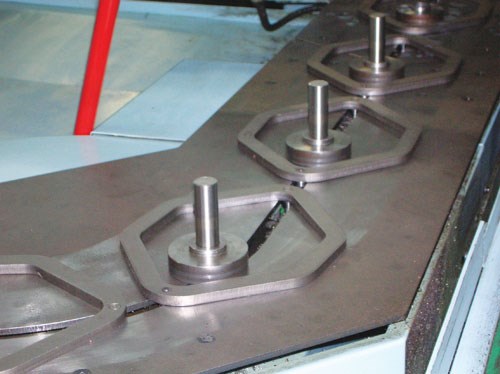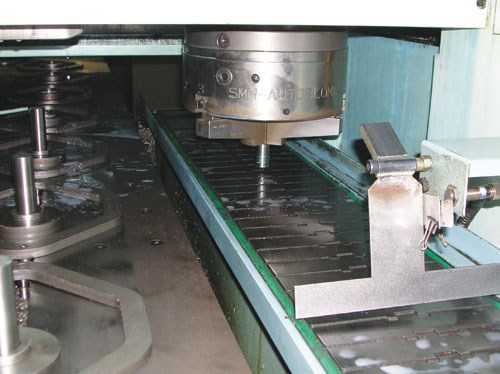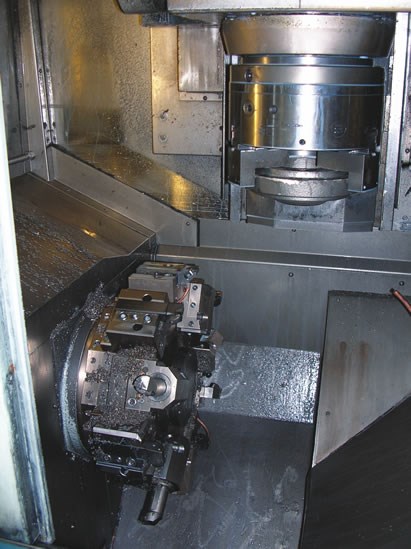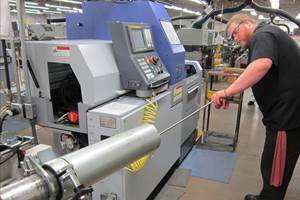A One Stop Shop
Combining flexible manufacturing with volume production capability helps this shop cover all the bases.
As sometimes happens, the lead for this article came in, as we say in the magazine biz, “over the transom.” I had received an e-mail newsletter from Eurotech Elite that featured a video testimonial from customer Justin Franklin, third-generation family owner at Kadon Precision Machining in Rockford, Ill.
Justin’s presentation focused on his shop’s incorporation of inverted vertical turning as part of Kadon’s overall strategy to continue its use of a variety of different machine tool technologies in order to be a more valuable supplier to its customers. Intrigued, I arranged to visit the shop to find out more.
On arrival, Justin welcomed me and introduced his father, Jeff, who serves as company president. We sat down to discuss Kadon and find out more about the shop’s success.
Founded in 1972 by Jeff and his father Jim, Kadon started life with three Greenlee screw machines. “Greenlees were built here in Rockford, and my grandfather built Greenlee machines,” Justin says. “Some of our older machines were actually built by my grand-father. We feel a connection.”
Like so many successful shop owners I’ve had the pleasure to learn from, this father and son team possesses similar traits: a passion for the work and a pragmatic willingness to revise their comfort zone as customer needs change. Jeff says, “Basically, what drives us is having fun, exploring new stuff and giving our employees opportunity to work on state-of-the-art equipment. We stay competitive that way. It’s what drives all of our changes.”
A Shop on a Mission
“Another driver is that we want to be a ‘one-stop shop’ for our customers. That’s been an evolving strategy since we added our first CNC machine in 1978,” Justin says.
To that end, the shop’s machine tool inventory includes horizontal and vertical machining centers, single and twin spindle horizontal lathes, Swiss-type turning centers and multi-spindle machines. “Many of these machines are equipped with auto-loaders to allow our operators to efficiently run more machines at a time,” he adds.
“Currently our largest piece is 19 inches in diameter, and we make parts down to 0.093-inch diameters,” he continues. This production machining range permits Kadon to process virtually any material from plastics to exotics in bar, blanks, forgings and castings.
“Our goal here is to make our customer comfortable with the shop’s ability to not only make this part for them, but realize our capability to make many other parts they may source elsewhere,” Justin explains. “While some shops push their core competency—describing themselves as a Swiss shop or a milling shop—we were founded as a precision screw machine house and have grown the business with extensive additional metalworking capability. My dad and I believe you have to do a lot of different things and service many different industries to survive in this business.”
Kadon is set up to handle many different parts and differing volumes. Some jobs run 1 million parts a year, or more, while others only 50 per year. The key is to be able to profitably manufacture such ranges. Jeff also cites Kadon’s ability to quickly turn around an order as a competitive edge that comes from having a wide, flexible stable of machines. “U.S. manufacturing can compete well on all levels and especially has an advantage being close to the market as far as delivery turn around,” he says.
Auto-Load
“We like the concept of auto-loading machines because it reduces the need for an operator to be on station constantly,” Jeff says. “Freeing up the operator from load/unload duties allows us to use employees more efficiently on higher value added tasks. Production is more consistent and predictable with reduced human intervention. It makes for more engaged employees as well.”
At Kadon, machine types are generally one brand. For example, their Swiss-types are all Citizen, the twin spindle lathes are Eurotech and most of the vertical mills are Haas. The idea is to push the operators to explore new production methods.
“I want our people to be able to operate all of the same types of machines in every department without hesitation,” Justin says. “We’ve standardized all of our paperwork, routers, production schedules, setup sheets and so on, so our people are comfortable working on machines of the same type or different type.”
The company first installed an auto-loaded machine in 1992. The benefits were obvious from the start. And as improvements to the technology advanced, from hydraulic actuation to pneumatic and ultimately programmable servos, Kadon kept up.
“Setup reduction for the auto load was a driver for us to continue to invest in newer technology,” Justin says. “On the earlier auto-load machines, upwards of eight grippers had to be swapped out for change-over. These also had to be made for the new job.”
While the untended production advantages of auto-loading on chuckers were obvious, the setup time was relatively high. Adjusting loader strokes, changing grippers and fixturing could take 6 to 8 hours.
Up Sides of Upside Down
To build on the advantages of its auto-load commitment, without the setup headaches of more conventional designs, Kadon explored the inverted vertical turning lathe. “I started looking at inverted vertical spindle machines about 6 to 8 years ago,” Jeff recalls. “I knew that was the direction we had to go because of the ease of setting up automation. My goal is to justify automation down to a lot size of 25 pieces.”
I concur with Jeff’s views on the need to consider this technology. When I first encountered an inverted vertical turning machine in the early 1980s at IMTS, it struck me then that this concept is a “forehead slapper” as in “why didn’t someone think of this before?”
On a conventional vertical turning lathe, the main spindle and workpiece are placed near the ground, while the cutter moves in X and Z above: chips fall on the part. In the inverted vertical design, this configuration is flipped. The main spindle traverses the workzone in the X axis and feeds the chucked part vertically in the Z axis: chips fall away from the part.
What’s very efficient in this design, and what caught Kadon’s eye, is its ability to use the main spindle as an auto-loader. The main spindle traverses out of the workzone to an integral conveyor that holds the blank work. On its way, the chuck or collet drops a finished part on a discharge belt. It then moves to the conveyor, picks up a blank and re-enters the workzone.
The inverted vertical machine Kadon settled on is the BV model from Italian builder Biglia. This machine line is imported through Eurotech. Kadon now has two of these machines on its floor. Its model BV 315 has live tooling and the second model BV 210 is straight turning. “Even though these machines are different sizes, we standardized on the three jaw chucks and set both tables at the same height to smoothly transition work from one machine to the other as demand dictates,” Justin says.
“The addition of these machines to our inventory has been a boon for enhancing our strategy of being a one-stop shop,” he continues. “We process slugs from 1.5-inches to 10 inches in diameter and larger, with setup of minutes from job-to-job.”
To set the machine, which uses a three-jaw chuck on the main spindle, the jaws need to be bored, tools changed and the blanks defined by center point and height to the CNC. With that done, the machine is ready to run.
On the BV, a parts conveyor surrounds the machine tool and queues part blanks for processing. It also has a discharge chute for finished parts. Capacity on the conveyor depends on the blank’s diameter.
To locate the blanks on the conveyor, the BV uses a prism holder. In effect, it acts like a vertical V-block by automatically locating blanks of different diameters in the V. To program the spindle for pick-up, only the part’s height and diameter need be given to the CNC. On the pick-up station, a spring-loaded pallet is depressed by the spindle to ensure a proper grip of the workpiece blank. Sensors signal any misloads.
In Production
With the machines installed, the Franklins set about seeing “what she can do.” The first order of business was to arrange the BVs in a production cell. This cell is comprised of the inverted vertical machine teamed with a single spindle Hardinge lathe.
Since it is difficult to balance an Operation 10 and Operation 20 precisely, the BV is set up to perform the longer cycle work, then feeds to the Hardinge for back turning operations. Both of the shop’s inverted verticals are arranged in this manner. As time and production demand, a robot may eliminate the secondary Operation 20 by acting as a roll-over station so the verticals can machine parts complete.
“What we quickly found out was that this machine configuration could produce parts that wouldn’t seem appropriate,” Justin says. “One in particular comes to mind. It’s an adapter cage for the hydraulic industry. We’ve always run this using 1.5-diameter hex bar on our twin-spindle Eurotech.
“Our problem was bar whip, which limited the turning speed to around 400 rpm. My dad said, ‘Let’s try it on the BV.’ We cut slugs and made a hex holder from neoprene to use on the conveyor. We were able to machine the parts at 1,750 rpm and at the end of the day, we got more production from the inverted vertical than the twin spindle horizontal. I think the applications for this machine are only limited to the shop’s imagination.”
Jeff brings up another non-intuitive job that was successfully applied to the vertical. “We made a rectangular part from slugs 8 inches long. It called for milling all four sides and cross drilling some holes. There was no turning at all. Because of the automatic load/unload and live tooling on the BV, it was able to out-produce a vertical machining center. At the end of the day, the lathe made more parts. This machine concept lets us think outside the box.”
Down the Road
Kadon’s owners believe that the company’s growth is predicated on anticipating change through communication with its customers, thereby identifying opportunity, and then developing a partnership around a new process that satisfies the opportunity. They are not afraid to invest in new machines or processes to keep the business moving forward.
“I see rotary transfer machining as opportunity, along with micro-machining, EDM and laser machining, to name a few,” Jeff says. “We want to stay on the road of building this company to do anything. As I see it, our biggest competitor is a customer with machining capability. We must make it attractive for that customer to vend out its work to us rather than bring it in-house. It’s a challenge that keeps us evolving.”
Related Content
CAM-Driven Lathe Questions
There can be hidden issues using legacy cam-driven lathes that can be overcome using new CNC technology. Here are three to keep in mind.
Read More6 Tips for Training on a Swiss-Type Lathe
There are nuances to training a person to effectively operate a Swiss-type lathe. A shop I visited a while back offers some suggestions.
Read More5-Axis Machining Centers Transform Medical Swiss Shop
Traditionally a Swiss machine shop, Swiss Precision Machining Inc. discovers a five-axis machining center that has led the company to substantial growth. (Includes video.)
Read MoreChoosing the Right Machine for Turned and Milled Medical Parts
The medical market is known for exceptionally tight tolerances and difficult materials, which means that selecting the proper machine is necessary to ensure a job is profitable.
Read MoreRead Next
Vertical Turning Proves Profitable
A precision machined parts manufacturer augments its production turning operations by expanding its CNC equipment and infrastructure to include vertical turning of large parts. The result has been a lucrative—and growing—additional revenue stream.
Read MoreVertical Turning Upside Down
Using the main spindle for double-duty machining and workpiece load/unload makes sense. It’s a simple idea that has grown in sophistication from turning to multitasking. This article looks at the state of the art using inverted vertical turning for precision volume production.
Read MoreDo You Have Single Points of Failure?
Plans need to be in place before a catastrophic event occurs.
Read More












.jpg;maxWidth=300;quality=90)













